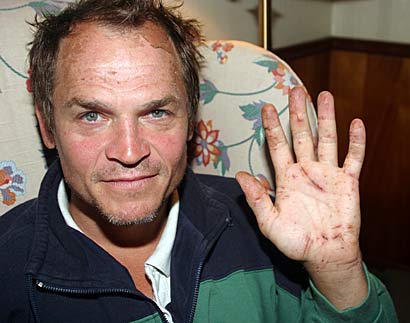
|
A true
(and lucky)
survivor
Water squeezed from moss helps
sustain a lost hiker for five days
in a Big Island lava field
WAIMEA, Hawaii » A Texas man who spent five days lost in a lava field near the Big Island's Kilauea volcano said yesterday that he survived by squeezing water from moss he found on trees sprinkled across an otherwise barren landscape.
SAFE HIKING TIPS
» Always tell someone where you are going and when you plan to return.
» Hike with a partner. » Get information about the route. » Make sure your fitness and experience fit the difficulty of the trail. » Wear proper clothing, including hiking boots and rain gear. » Carry at least two quarts of water per person for a full-day hike. » Bring a day-pack or waist-pack with some food, a whistle, sunscreen, bug repellent, a small flashlight, basic first-aid kit and a bright article to wave if stranded. » Watch the time and don't get caught out after dark. » Carry a cell phone but remember that it might be out of range in some mountain areas. Source: State Department of Land and Natural Resources
|
He had been missing since Sunday night, when he decided to take a hike across the barren and desolate lava fields to get a closer look at the active volcano.
The 41-year-old experienced hiker from Austin, Texas, said he saw no water anywhere, but there were pockets of jungle-like vegetation sprinkled throughout the old lava flow.
Gaedcke said he would crawl beneath the vines and lick moisture off leaves. Then he found moss growing on the trees and was able to squeeze enough water from it to drink.
"It was muddy, green, mossy water, but it worked," he said. "If I hadn't found that I'd be dead right now."
Gaedcke said tour helicopters had flown overhead all week, but he was unable to attract attention because the cloud cover blocked the sun.
Then late Friday afternoon, 15-year-old Peter Frank, a tourist on a helicopter tour, spotted an odd glint in the late afternoon sunlight.
"It was the only thing like that out there," said Frank, of Pasadena, Calif. "As we got closer we realized it was a man."
It was Gaedcke, dehydrated but otherwise OK after surviving five days in the heat, lost amid acres of blackened volcanic rock.
"I wound up on some of the most vicious terrain I've ever seen," Gaedcke said yesterday as he rested at a friend's home before flying home to Texas last night. "It's all gray rock -- terrible stuff -- then vegetation like an oasis, then more gray rock."
Gaedcke's rented car had been found days earlier at the end of a road near an old lava flow bordering the east side of the 333,000-acre Hawaii Volcanoes National Park.
Fire crews and rangers from the adjacent Hawaii Volcanoes National Park searched for days, on foot and on horseback. Helicopters buzzed the area, but there was no sign of Gaedcke.
No sign, until Frank spotted what he thought was a toy pinwheel glinting in the sunlight.
When her son asked Blue Hawaiian Helicopters pilot Cliff Muzzi to get a closer look, Frank's mother, Diann Kim, said Muzzi replied, "Well, let's go check it out."
"As we got closer you could see the man flashing a mirror and waving a dark orange fabric," she said. "As he was coming down the path, clearly he couldn't move that well."
Muzzi circled for 20 minutes, Kim said, then radioed the authorities, giving them Gaedcke's exact location.
Meanwhile, Kim's daughter, Hannah, and a friend wrapped bottles of water in airsickness bags to drop to the distressed hiker.
"It was so amazing," Kim said. "To see a person out there was like seeing a person on the face of the moon."
After returning his passengers to Hilo International Airport, Muzzi headed back for Gaedcke, then whisked him back to the airport, some 17 miles to the northeast. Medical crews were waiting to take him to Hilo Medical Center.
Gaedcke said he had seen the bright glow of the lava but then missed his car walking back in the dark. He hiked inland, expecting to intersect with the road, but he was lost by morning.
His feet and hands were cut up from stumbling on the sharp lava rock, and he estimates he walked about 10 miles during the five days, spending most of that time searching for water.
Gaedcke stayed at the hospital for three hours Friday and left with his sister, Tracy Smith, of Houston, who had flown in Thursday morning and had made public appeals on television in the search for her brother, who is a computer consultant in Austin.
Gaedcke, who has two young daughters at home, said he had many reasons to survive. He and his sisters said they thanked everyone involved in the search.
"My feet feel like I had a 30-day adventure," he said. "And if it weren't for my feet, I'd be dancing a jig right now."
E-mail to City Desk
[News] [Business] [Features] [Sports] [Editorial] [Do It Electric!]
[Classified Ads] [Search] [Subscribe] [Info] [Letter to Editor]
[Feedback]
